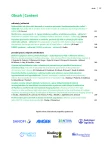PCSK9 inhibitors – new possibilities in the treatment of hypercholesterolemia: For which patients will be indicated?
Czech atherosclerosis society statement
Authors:
Vladimír Soška 1,2,3; Michal Vrablík 4; Vladimír Bláha 5; Renata Cífková 6; Richard Češka 4; Tomáš Freiberger 7; Pavel Kraml 8; Jan Piťha 9; Hana Rosolová 10; Tomáš Štulc 4; Helena Vaverková 11; Zuzana Urbanová 12
Authors‘ workplace:
Oddělení klinické biochemie, ICRC – oddělení kardiovaskulárních chorob FN u sv. Anny v Brně
1; II. interní klinika LF MU a FN U sv. Anny v Brně
2; Katedra laboratorních metod LF MU, Brno
3; Centrum preventivní kardiologie III. interní klinika 1. LF UK a VFN v Praze
4; III. interní gerontometabolická klinika LF UK a FN Hradec Králové
5; Centrum kardiovaskulární prevence 1. LF UK a Thomayerovy nemocnice, Praha
6; Centrum kardiovaskulární a transplantační chirurgie Brno
7; II. interní klinika 3. LF UK a FN Královské Vinohrady, Praha
8; Centrum experimentální medicíny IKEM, Praha
9; II. interní klinika LF UK a FN Plzeň
10; III. interní klinika – nefrologická, revmatologická a endokrinologická LF UP a FN Olomouc
11; Klinika dětského a dorostového lékařství 1. LF UK a VFN v Praze
12
Published in:
Vnitř Lék 2016; 62(4): 329-333
Category:
Guidelines
Overview
First line drug for the treatment of hypercholesterolemia are statins, which reduce LDL-cholesterol up to 50 %; such reduction is sufficient for most patients to achieve the target values. The exceptions are patients with familial hypercholesterolemia and patients with statin intolerance. To achieve target LDL-cholesterol in these two groups of patients will be possible with new drugs – PCSK9 inhibitors, which decrease LDL-cholesterol by an additional 50–60 %. The first two PCSK9 inhibitors (alirocumab and evolocumab) already had been approved for clinical use by European regulatory authorities. The primary indication for combination statin with PCSK9 inhibitor should be undoubtedly patients with a confirmed diagnosis of familial hypercholesterolemia, who are treated in the Czech Republic primarily in specialized centers of MedPed project. Furthermore, this treatment should be available for other patients at very high risk of cardiovascular diseases, who cannot achieve target LDL-cholesterol (eg. for statins intolerance).
Key words:
familial hypercholesterolemia – LDL-cholesterol – PCSK9 inhibitors – statins
Sources
1. Robinson JG, Farnier M, Krempf M et al. Efficacy and safety of alirocumab in reducing lipids and cardiovascular events. N Engl J Med 2015; 372(16): 1489–1499.
2. Sabatine MS, Giugliano RP, Wiviott SD et al. Efficacy and safety of evolocumab in reducing lipids and cardiovascular events. N Engl J Med 2015; 372(16): 1500–1509.
3. Raal FJ, Giugliano RP, Sabatine MS et al. Reduction in lipoprotein(a) with PCSK9 monoclonal antibody evolocumab (AMG 145): a pooled analysis of more than 1,300 patients in 4 phase II trials. J Am Coll Cardiol 2014; 63(13): 1278–1288.
4. Nordestgaard BG, Chapman MJ, Humphries SE et al. Familial hypercholesterolaemia is underdiagnosed and undertreated in the general population: guidance for clinicians to prevent coronary heart disease: consensus statement of the European Atherosclerosis Society. Eur Heart J 2013; 34: 3478a-3490a. Dostupné z DOI: <http://http://dx.doi.org/10.1093/eurheartj/eht273>.
5. Watts GF, Gidding S, Wierzbicki AS et al. Integrated guidance on the care of familial hypercholesterolaemia from the International FH Foundation. Int J Cardiol 2014; 171(3): 309–325.
6. Vrablík M, Češka R, Freiberger T et al. Souhrn konsenzu panelu expertů European Atherosclerosis Society k otázce diagnostiky a klinickému vedení nemocných s homozygotní formou familiární hypercholesterolemie. Hypertenze a KV prevence 2015; 4: 59–61.
7. Vrablík M, Freiberger T, Bláha V et al. Souhrn konsenzu panelu expertů European Atherosclerosis Society k otázce diagnostiky a klinickému vedení nemocných s familiární hypercholesterolemií. Hypertenze a KV prevence 2015; 4: 44–48.
8. Informace dostupné z WWW: <http://www.athero.cz/cze/projekt-medped.html>.
9. Stroes ES, Thompson PD, Corsini A et al. Statin-associated muscle symptoms: impact on statin therapy-European Atherosclerosis Society Consensus Panel Statement on Assessment, Aetiology and Management. European Heart Journal 2015; 36(17): 1012–1022.
10. Pella D, Gvozdjáková A, Lietava J et al. Myopatie asociovaná se statiny: klinické doporučení Slovenskej asociácie aterosklerózy a České společnosti pro aterosklerózu. Atheroreview 2015; 1(1): 7–13.
Labels
Diabetology Endocrinology Internal medicineArticle was published in
Internal Medicine

2016 Issue 4
Most read in this issue
- DRESS syndrome
-
PCSK9 inhibitors – new possibilities in the treatment of hypercholesterolemia: For which patients will be indicated?
Czech atherosclerosis society statement - Beta-blockers and chronic obstructive pulmonary disease
- Chronic kidney diseases, metformin and lactic acidosis
